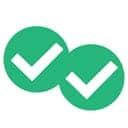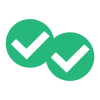But what do these sayings actually mean? What specific items can you choose to make a good impression at your next job interview?
Truthfully, the type of clothes you should wear will largely depend on the type of job you want. However, you shouldn’t rely on this alone. Dress codes can differ from one company to another, even if these companies are hiring for the same position. Many organizations use specific terminology to dictate how you should dress for your job interview.
Dress Code Terminology
There are essentially four categories of dress in professional settings: casual, business casual, business professional, and business formal. You might be wondering, “What do these terms mean?” while flipping through the items in your wardrobe.
Read on to get a breakdown of each term, along with examples of what fits into each category.
Casual
“Casual attire” can mean different things to different people. Overall, it refers to everyday wear. However, you should still dress a little more formally than you would around the house or when you’re running errands. Make sure that all of your clothes, shoes, and accessories are clean before the interview.
Let’s consider a few examples of “casual attire” for both men and women:
- Acceptable Interview Attire for Men – Slacks, fitted jeans, khakis, collared shirts, loafers, tennis shoes, pullovers.
- Acceptable Interview Attire for Women – Fitted tops or blouses, slacks, khakis, medium-length skirts, fitted jeans, tennis shoes, open-toed shoes.
- Clothes to Avoid – Flip-flops, old sneakers, t-shirts, clothing with novelty patterns, acid-washed jeans, shorts.
Business Casual
“Business Casual” is one of the most common forms of interview attire. It combines the comfort of casual attire with the professionalism of more formal dress codes.
While there are no exact guidelines for business casual, it could be described as a form of casual attire that excludes jeans and tennis shoes. Business casual patterns and colors are also more conservative.
Here are a few concrete examples of “business casual” attire for men and women:
- Acceptable Interview Attire for Men – Slacks, khakis, button-down shirts, neckties, sports jackets, knit pullovers, dress shoes, loafers.
- Acceptable Interview Attire for Women – Fitted blouses, khakis or black pants, loafers, closed-toed pumps, flats, jackets.
- Clothes to Avoid – Flip-flops, t-shirts, clothing with novelty patterns, shorts, jeans, tennis shoes.
Business Professional
“Business professional” generally refers to suits and similar attire required for formal situations.
Most “desk jobs” in offices, board rooms, and similar workspaces will require (at minimum) business professional attire during the interview process and sometimes work hours.
Usually, if no dress code is stated for the interview, “business professional” should be your default. It looks professional and helps to make a good first impression. Business professional colors should always be conservative (dark blue, black, gray, and brown).
Let’s look at some specific examples of “business professional” attire for men and women:
- Acceptable Interview Attire for Men – Suits (conservative colors), ties, dress pants, sports jackets, button-down shirts, oxford shoes, loafers.
- Acceptable Interview Attire for Women – Suits (conservative colors), knee-length skirts, dress pants, button-down shirts, jackets, hosiery, closed-toed pumps or flats.
- Clothes to Avoid – Shorts, jeans, tennis shoes, khakis, clothing with bright colors or patterns.
Business Formal
“Business formal” is reserved for high-level job applicants in fields like law or executive management.
In the same way that “business casual” is a more formal version of “casual,” “business formal” is simply a more formal, tailored version of “business professional.” It consists almost entirely of tailored suits and pantsuits of black, gray, or navy.
In any case, consider some examples of “business formal” attire for men and women:
- Acceptable Interview Attire for Men – Tailored suits (neutral colors), ties, button-down shirts, black or brown oxford shoes.
- Acceptable Interview Attire for Women – Pantsuits or skirt suits (neutral colors), heels.
- Clothes to Avoid – Open-toed shoes, any casual or business casual attire
How Dress Codes Vary by Organization Type
Some organizations have a strict dress code, while others are relatively lax. Figuring out what kind of attire an organization expects its employees (and job applicants) to wear can be as simple as Googling the name of the organization.
However, not every business or start-up has this kind of information available online. Thankfully, many organizations tend to conform to the standards set in years past, which makes it a little easier to plan your wardrobe in advance.
Here are a few common types of organizations and their respective dress codes:
- Corporation – Corporate culture is usually associated with business formal and professional attire. However, corporations hire for a wide range of positions, many of which don’t involve board rooms or offices. In any case, corporations and larger businesses almost always have a set of guidelines for how employees should dress around the workplace (including interviews).
- Brick-and-Mortar Business – Smaller businesses may or may not have a strict dress code, as it is entirely up to the business owner. Employees may need to wear a uniform during work hours, though this would not apply to the initial interview. As a result, the job interview dress code for small or family-owned businesses can vary.
- Start-Up – Just as corporations are associated with formal attire, start-ups are generally associated with more casual (or informal) attire. Though it is not always the case, those applying to work for a start-up can likely wear business casual clothing. It is always better to overdress than underdress, so it is not recommended to wear casual attire to a start-up interview unless explicitly told to do so.
- Nonprofit – Nonprofits come in all shapes and sizes. Like corporations, most large non-profits have a strict dress code. Alternatively, smaller nonprofits may or may not institute a dress code at all.
Do Your Research Before the Interview
Ultimately, every business or organization has different dress code standards. Even if you’re applying for the same position at two different organizations, you may need to dress a little differently for each respective interview.
If you’re still unsure what to wear for your next job interview, don’t be afraid to ask. Tell your recruiter or interviewer that you would like a little information about the expected dress code for the interview.
When in doubt about their expectations, don’t be afraid to overdress. You may feel a little silly wearing business professional attire to an interview that only requires business casual attire, but it will likely have little or no effect on your ability to secure the job.
Alternatively, if you underdress for an important interview, you probably won’t make a very good impression. So, make sure to do your research and know what to wear to a job interview – this will put you on the right path to landing the job of your dreams!
Check out our interview advice video for more tips on figuring out what to wear to a job interview, including ways you can research the dress code before you even step foot in the office!
Real-World Dress Code Examples
To give you a better idea of what to expect, here are a few real-world dress code examples from some of the largest companies in the world:
- Amazon Interview Dress Code
- Google Interview Dress Code
- Facebook Interview Dress Code
- JPMorgan Chase Interview Dress Code
If you’d like to learn more about job interview techniques, visit Magoosh Speaking today!

